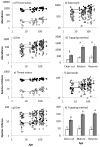Functional roles affect diversity-succession relationships for boreal beetles
- PMID: 23977350
- PMCID: PMC3748087
- DOI: 10.1371/journal.pone.0072764
Functional roles affect diversity-succession relationships for boreal beetles
Abstract
Species diversity commonly increases with succession and this relationship is an important justification for conserving large areas of old-growth habitats. However, species with different ecological roles respond differently to succession. We examined the relationship between a range of diversity measures and time since disturbance for boreal forest beetles collected over a 285 year forest chronosequence. We compared responses of "functional" groups related to threat status, dependence on dead wood habitats, diet and the type of trap in which they were collected (indicative of the breadth of ecologies of species). We examined fits of commonly used rank-abundance models for each age class and traditional and derived diversity indices. Rank abundance distributions were closest to the Zipf-Mandelbrot distribution, suggesting little role for competition in structuring most assemblages. Diversity measures for most functional groups increased with succession, but differences in slopes were common. Evenness declined with succession; more so for red-listed species than common species. Saproxylic species increased in diversity with succession while non-saproxylic species did not. Slopes for fungivores were steeper than other diet groups, while detritivores were not strongly affected by succession. Species trapped using emergence traps (log specialists) responded more weakly to succession than those trapped using flight intercept traps (representing a broader set of ecologies). Species associated with microhabitats that accumulate with succession (fungi and dead wood) thus showed the strongest diversity responses to succession. These clear differences between functional group responses to forest succession should be considered in planning landscapes for optimum conservation value, particularly functional resilience.
Conflict of interest statement
Figures



Similar articles
-
Saproxylic and non-saproxylic beetle assemblages in boreal spruce forests of different age and forestry intensity.Ecol Appl. 2010 Dec;20(8):2310-21. doi: 10.1890/09-0815.1. Ecol Appl. 2010. PMID: 21265460
-
Micro and macro-habitat associations in saproxylic beetles: implications for biodiversity management.PLoS One. 2012;7(7):e41100. doi: 10.1371/journal.pone.0041100. Epub 2012 Jul 25. PLoS One. 2012. PMID: 22848432 Free PMC article.
-
Lower alpha, higher beta, and similar gamma diversity of saproxylic beetles in unmanaged compared to managed Norway spruce stands.PLoS One. 2022 Jul 8;17(7):e0271092. doi: 10.1371/journal.pone.0271092. eCollection 2022. PLoS One. 2022. PMID: 35802717 Free PMC article.
-
Forest management strategy affects saproxylic beetle assemblages: A comparison of even and uneven-aged silviculture using direct and indirect sampling.PLoS One. 2018 Apr 10;13(4):e0194905. doi: 10.1371/journal.pone.0194905. eCollection 2018. PLoS One. 2018. PMID: 29634728 Free PMC article.
-
Conservation value of low-productivity forests measured as the amount and diversity of dead wood and saproxylic beetles.Ecol Appl. 2018 Jun;28(4):1011-1019. doi: 10.1002/eap.1705. Epub 2018 May 21. Ecol Appl. 2018. PMID: 29446863
Cited by
-
Environmental conditions alter successional trajectories on an ephemeral resource: a field experiment with beetles in dead wood.Oecologia. 2020 Oct;194(1-2):205-219. doi: 10.1007/s00442-020-04750-5. Epub 2020 Oct 7. Oecologia. 2020. PMID: 33026525 Free PMC article.
-
Progress toward a list of saproxylic beetles (Coleoptera) in the southeastern USA.Zookeys. 2025 Mar 14;1232:1-95. doi: 10.3897/zookeys.1232.143989. eCollection 2025. Zookeys. 2025. PMID: 40201198 Free PMC article.
-
Within-season changes in habitat use of forest-dwelling boreal bats.Ecol Evol. 2020 Apr 13;10(9):4164-4174. doi: 10.1002/ece3.6253. eCollection 2020 May. Ecol Evol. 2020. PMID: 32489639 Free PMC article.
-
Influence of European Beech (Fagales: Fagaceae) Rot Hole Habitat Characteristics on Invertebrate Community Structure and Diversity.J Insect Sci. 2021 Sep 1;21(5):7. doi: 10.1093/jisesa/ieab071. J Insect Sci. 2021. PMID: 34553221 Free PMC article.
-
Saproxylic Beetle Assemblage Selection as Determining Factor of Species Distributional Patterns: Implications for Conservation.J Insect Sci. 2016 Jun 1;16(1):45. doi: 10.1093/jisesa/iew030. Print 2016. J Insect Sci. 2016. PMID: 27252483 Free PMC article.
References
-
- Jeffries JM, Marquis RJ, Forkner RE (2006) Forest age influences oak insect herbivore community structure, richness, and density. Ecol Appl 16: 901-912. doi:10.1890/1051-0761(2006)016[0901:FAIOIH]2.0.CO;2. PubMed: 16826990. - DOI - PubMed
-
- Hart SA, Chen HYH (2008) Fire, logging, and overstory affect understory abundance, diversity, and composition in boreal forest. Ecol Monogr 78: 123-140. doi:10.1890/06-2140.1. - DOI
-
- Fenton NJ, Bergeron Y (2008) Does time or habitat make old-growth forests species rich? Bryophyte richness in boreal Picea mariana forests. Biol Conserv 141: 1389-1399. doi:10.1016/j.biocon.2008.03.019. - DOI
-
- Lindenmayer DB, Franklin JF, Fischer J (2006) General management principles and a checklist of strategies to guide forest biodiversity conservation. Biol Conserv 20: 949-958. doi:10.1111/j.1523-1739.2006.00497.x. - DOI
-
- Gibb H, Pettersson RB, Hjalten J, Hilszczanski J, Ball JP et al. (2006) Conservation-oriented forestry and early successional saproxylic beetles: Responses of functional groups to manipulated dead wood substrates. Biol Conserv 129: 437-450. doi:10.1016/j.biocon.2005.11.010. - DOI
Publication types
MeSH terms
LinkOut - more resources
Full Text Sources
Other Literature Sources

